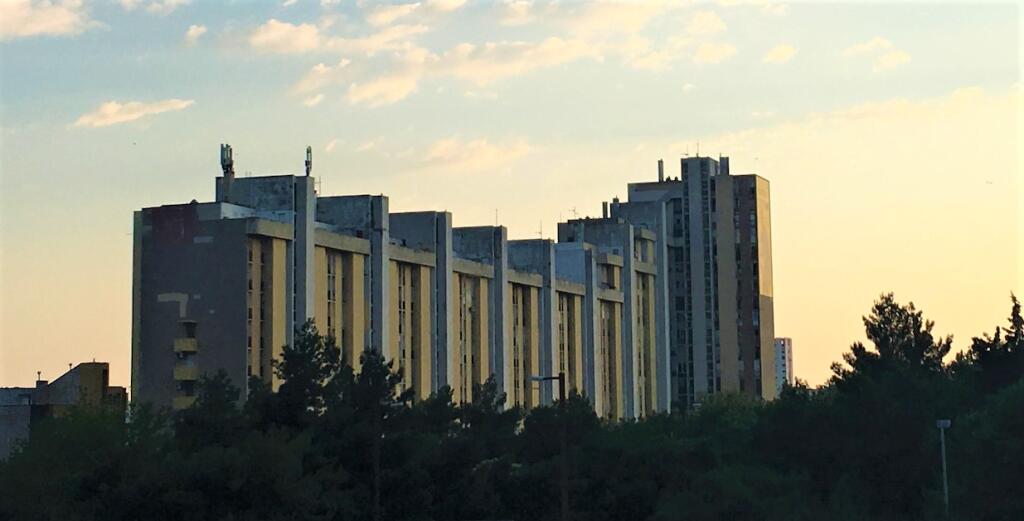The Legacy of the Non-Aligned Movement – The Dream of Peaceful Coexistence and Encouragement of Cultural Diversity
Did you know that the 1st Conference of the Non-Aligned Movement took place right in the heart of South East Europe?
The Non-Aligned Movement (NAM) was formally established nearly 60 years ago—in one of the regions our festival covers—Belgrade, in today’s Serbia, then the capital of Yugoslavia. The first official conference of the non-aligned countries took place in September 1961, with 25 countries participating.
In short, NAM was founded during the Cold War by leaders from countries that aimed to establish the principle of peaceful coexistence and remain non-aligned with either of the two power blocs—the United States and the Soviet Union.
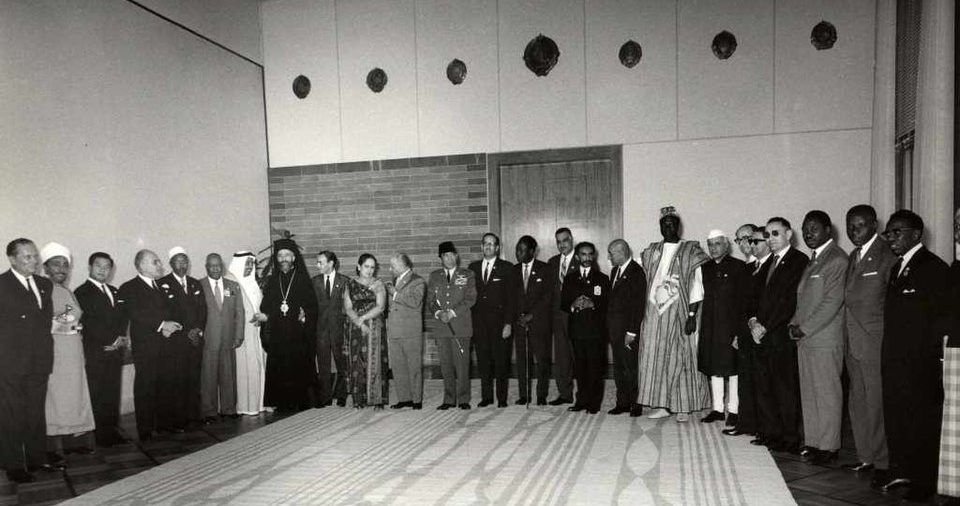
Leaders of the Global South at the Belgrade Summit 1961, © Museum of Yugoslavia, Belgrade
“In September 2021 we mark the 60th anniversary of the Belgrade Conference of the Non-Aligned Countries. Recent academic meetings and exhibitions (like the one held in 2019 at the Wende Museum in Los Angeles, titled Nonalignment and Tito in Africa) have at long last blown open the lid of inquiry on an important historical period and movement which offered an alternative approach to global affairs. Non-aligned movement forged previously unthinkable geographical alliances and challenged bi-polar global policies of the time. We need to explore Non-Alignment from a humanist, cultural, and public diplomacy angles, similar to what the world is trying to do today with a global agenda on climate change”, says Vera Mijojlić, founder of SEEfest.
Let’s take a look at the initial steps that led to the formation of NAM—which is the largest grouping of states just after the United Nations—and look at the deeper implications of how this movement worked toward peaceful coexistence.
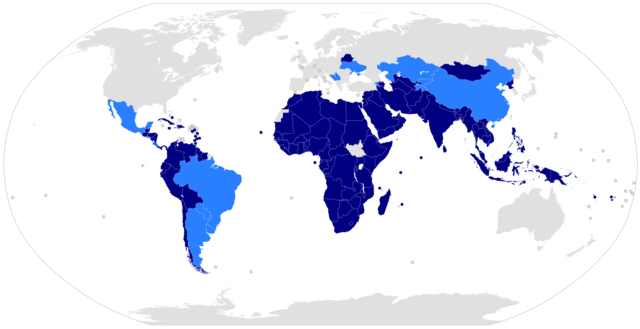 To begin, the Cold War is directly responsible for the emergence of the terms, “first world”, “second world”, and “third world” —the western and eastern blocs, and the nations that decided to stay outside of these blocs.
To begin, the Cold War is directly responsible for the emergence of the terms, “first world”, “second world”, and “third world” —the western and eastern blocs, and the nations that decided to stay outside of these blocs.
Alfred Sauvy, a French demographer coined the term “third world” in his 1952 article, “Three Worlds, One Planet”. The “first world” was meant to refer to the United States and its democratic-capitalists allies like Western Europe, Japan, and Australia; and the Eastern bloc, the Soviet Union and “its Eastern Europe satellites” were considered the “second world”. The “third world” then comprised of the nations that chose to be non aligned, and which were also considered underdeveloped as many had just recently won independence from their European colonizers, like nations in Africa, Asia, the Middle East, and Latin America.
In 1955, twenty-nine government representatives from Asian and African countries—representing nearly 54% of the world’s population—met in Bandung, Indonesia at what would become known as the Bandung Conference, “to discuss peace, and the role of the third world in the Cold War, economic development, and decolonization.”
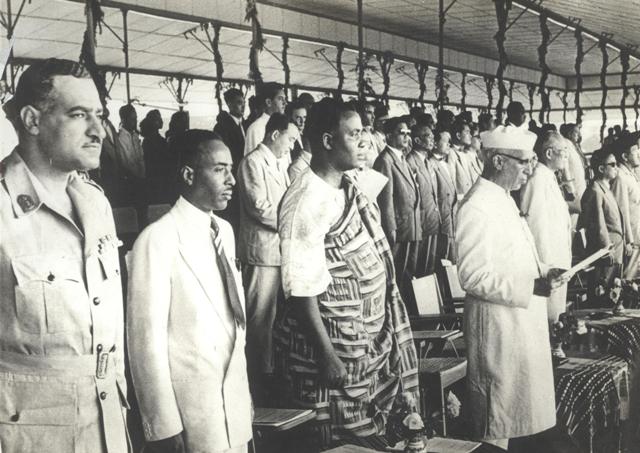
Asian-African Conference at Bandung, April 1955
These nations called upon the meeting out of the frustration and alienation they felt as the non-aligned “third world” and decided to come together to dispel colonization through their unity and support for one another as well as their advocacy for other nations that were still under colonial rule.
It was at this conference that they established and signed a communique of the principles they would stand by, which included: “the promotion of economic and cultural cooperation, protection of human rights and the principle of self-determination, a call for an end to racial discrimination wherever it occurred, and a reiteration of the importance of peaceful coexistence.” (Office of the Historian)
These principles and their concept of banding together to support one another economically and culturally laid a lot of the groundwork for the Non-Alignment Movement. They figured as a majority of them were newly freed of their colonial ties, they would use this unity to build one another up through peaceful coexistence, the dismantlement of colonialism and racism, and the promotion of diversity.
SEEfest promotes cross-border cultural diversity
Promoting lesser-known regions, their history, heritage, and their cultural diversity through film, literary and cultural events is at the core of SEEfest, a cultural festival that “pioneered the concept of regional, cross-border programming with issue-driven films that tell a larger story about South East Europe (…) by presenting multiple points of view from this troubled region,” to quote from the festival’s mission statement.
On the occasion of the historical 60th anniversary of the first NAM conference, we look back at the world as it was then, and how a small country in the heart of South East Europe, only recently freed from the oppressive dominance of the Eastern bloc, took center stage in hosting a meeting of Asian, African and Latin American countries. Aside from politics, this conference would have a lasting cultural influence on people and artists of Yugoslavia: from The Museum of African Art, the first and only museum in the region entirely dedicated to the cultures and arts of the African continent, to several recent documentary films about NAM and upcoming magnum opus by acclaimed filmmaker Mila Turajlic, “The Labudovic Files” about the cameraman who filmed not just the leaders of the movement but preserved on film living history and cultural traditions of many nations.
“We look back at the main protagonists and at what deep sense of solidarity Tito was able to instill wherever he went on his extensive travels. There is strong evidence of trust between Nonaligned nations — something not only completely absent from but pretty much unthinkable in our present world,” says Vera Mijojlić, founder of SEEfest.
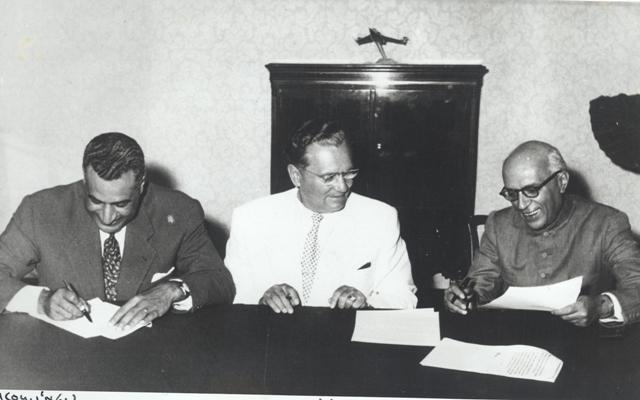
From Left to Right: Gamal Abdel Nasser, Josip Broz Tito, and Jawaharlal Nehru
NAM was headed by the president of Yugoslavia, Josip Broz Tito; the President of Egypt, Gamal Abdel Nasser; and the first Prime Minister of India, Jawaharlal Nehru.
Josip Broz Tito, who played a pivotal role in the movement, achieved something no other Eastern European nation succeeded in doing until the fall of the Berlin Wall: he managed to distance Yugoslavia from the Soviets and retreated from the USSR-led alliance in 1948. As stated in Non-Alignment and Tito in Africa, Tito defied “Soviet hegemony to launch (Yugoslav) own program of socialist development.”
Through his foreign policy and anticolonialism, Yugoslavia strengthened its ties and influence in the ‘third world’. Tito’s legendary travels to Africa, Asia, and Latin America have been well documented on film, primarily by the state-funded newsreel service Filmske Novosti. The company still exists and serves as a treasure trove of unique archival material for scores of young filmmakers, scholars, and media organizations throughout the world.
Extensive travels and Tito’s meetings with leaders of non-aligned African countries led to “economic packages, military aid, technical support, and cultural and academic exchanges, it helped build factories, power plants, ports, hospitals, and research facilities in numerous African countries. In return, Yugoslavia gained access to African raw materials and new markets to trade its surplus consumer products.” (Non-Alignment and Tito in Africa)
Tito also strengthened Yugoslavia’s ties with other third-world countries in South America, notably with Mexico, and this, in turn, introduced Mexican films from the golden age to Yugoslav audiences across the country. This then led to the 1950s-1960s “Yu-Mex” craze, when Mexican music became so popular in the region that many Yugoslav musicians began covering traditional Mexican music. The documentary film by Miha Mazzini, “Yugoslav Mexico” from 2013 is dedicated to this cultural phenomenon.
Another notable thing Yugoslavia did under Tito’s leadership was aid the third world in anti-colonialist movements, and it was the Yugoslav delegation that first brought the demands of the Algerian National Liberation Front to the United Nations.

Nelson Mandela
Later, another important figure that would serve as a Chair of the Non-Aligned Movement would be President Nelson Mandela. From September 1998 to June 1999 he served as NAM’s 19th Secretary General. After the 7th NAM Summit of 1998, he relayed the discussions and outcomes the group had to the United Nations General Assembly during their 53rd session.
SEEfest will continue to highlight this, and other influential historical and cultural milestones of South East Europe. Stay tuned for the next update!
Post your comments and memories of this historic event below. And be sure to sign up for the SEEfest News so you don’t miss important announcements about the annual Festival!
City Spaces: Diocletian’s Palace
At the heart of Split lies Diocletian’s Palace
Before Croatia became a country in its own right, the area was under the rule of various powers and empires, each of which has left its mark on its cities and culture. One of the earliest is the Romans, whose architecture formed the foundation from which cities such as Split continue to grow and evolve.
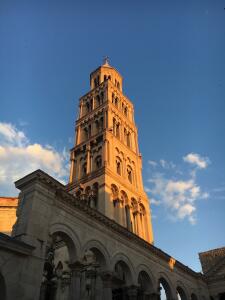 At the heart of Split lies Diocletian’s Palace, built at the start of the fourth century for the Roman emperor. The white stone that makes up its walls and streets are characteristic of the architecture in the city as well as the greater Dalmatian region and lighten the city even on the rare cloudy days.
At the heart of Split lies Diocletian’s Palace, built at the start of the fourth century for the Roman emperor. The white stone that makes up its walls and streets are characteristic of the architecture in the city as well as the greater Dalmatian region and lighten the city even on the rare cloudy days.
The palace has four arched entrances, fortress-like walls shielding all sides, and a bell tower, added later on around the twelfth century, that stands as the highest point in the city center. The wall, once bordering the Adriatic, now stands as the permeable boundary between the palace and the Riva, a walkway lined with cafes by the sea.
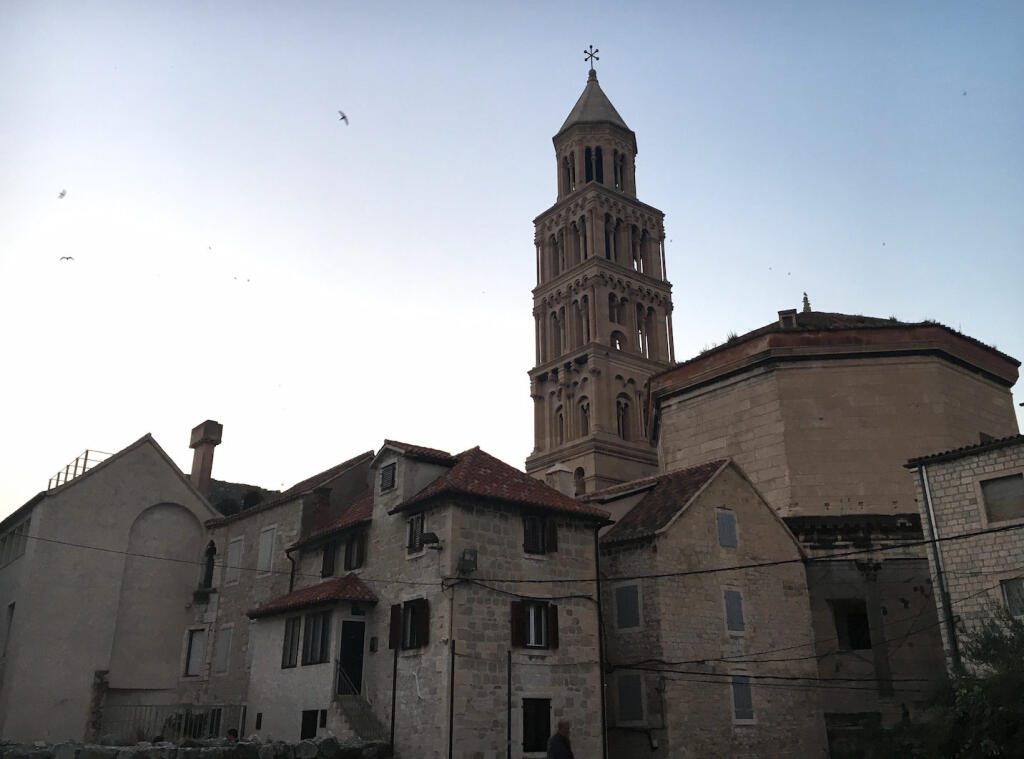 Once the site of defense and trade, now it is a social area of small-scale business. Underground is the palace’s cellars, with cavernous ceilings and cobblestones, which now house the stands of artists and artisans selling handmade jewelry, sculptures of wood and limestone, and tourist paraphernalia of all kinds. The ebb and flow of people through the palace’s streets follows time-worn paths; looking at the smooth, time-worn flagstones, one can see the repeated indentations of millions of steps.
Once the site of defense and trade, now it is a social area of small-scale business. Underground is the palace’s cellars, with cavernous ceilings and cobblestones, which now house the stands of artists and artisans selling handmade jewelry, sculptures of wood and limestone, and tourist paraphernalia of all kinds. The ebb and flow of people through the palace’s streets follows time-worn paths; looking at the smooth, time-worn flagstones, one can see the repeated indentations of millions of steps.
Over the many centuries since its construction, the palace’s narrow streets and tunnels, small squares, and leftover pillars have remained largely unchanged architecturally, but the spaces have transformed in functionality, serving new purposes with each new era.
In the time of Diocletian, the Peristyle—a large square lined by pillars—was the site of the emperor’s announcements and appearances, adjacent to a building that contained a mausoleum. That mausoleum later became known as the cathedral of Sveti Duje (Saint Domnius), where mass is still held today. The bell tower above it rings with every hour and is still a defining feature of the city’s skyline.
During certain periods this area of the palace was simply another part of the city center and everyday life, not used for any particular purpose. On one hand, this led to decay from lack of maintenance, but on the other, the palace was spared from external harm. Despite the turbulent events in this region throughout the twentieth century, Split remained largely untouched by the wars and skirmishes and none of the palace’s architecture had to be rebuilt as a result of wartime damage.
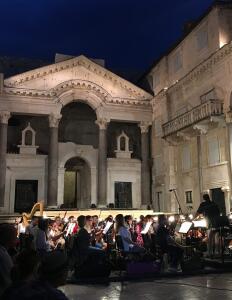 The Peristyle has come to be known as the city’s “living room,” a space where performances, from orchestras to street artists, are staged and people frequently gather to dance, eat and drink, and spend time together.
The Peristyle has come to be known as the city’s “living room,” a space where performances, from orchestras to street artists, are staged and people frequently gather to dance, eat and drink, and spend time together.
As tourists become an increasingly prominent presence in the city, there has been pushback against letting these cultural spaces turn into architectural and historical museums. After all, cities are made to be lived in, never truly preserved in a crystallized state. They take on a life of their own and transform with the times, constructing on top of their architectural and cultural foundations.
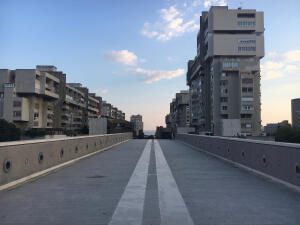 Beyond the walls, the liveliness of the palace spills out into the surrounding area. Layers of history take the form of ruins, parks, and houses, and on the outskirts of the city, the architecture transforms into modern apartments. Nevertheless, the essence of Mediterranean living has been preserved in these various forms. Open spaces and squares with coffee shops are ubiquitous and a source of food, socializing, exchange of information, and a part of everyday life. The way of living, persistent through the ages, is reflected in these spaces even as the city continues to evolve.
Beyond the walls, the liveliness of the palace spills out into the surrounding area. Layers of history take the form of ruins, parks, and houses, and on the outskirts of the city, the architecture transforms into modern apartments. Nevertheless, the essence of Mediterranean living has been preserved in these various forms. Open spaces and squares with coffee shops are ubiquitous and a source of food, socializing, exchange of information, and a part of everyday life. The way of living, persistent through the ages, is reflected in these spaces even as the city continues to evolve.
Göbeklitepe- The World’s First Temple
12,000 years ago, the world’s first temple, Göbeklitepe, was built near Urfa in Turkey.
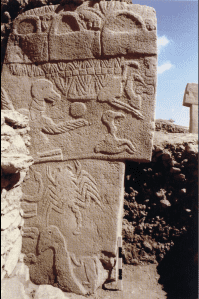 Massive carved stones were arranged in rings by prehistoric people who had not yet developed metal tools. The stones are covered in carvings of foxes, lions, vultures, and scorpions using only stone hammers and blades. The tallest pillar is 16 feet and the site pre-dates Stonehenge by 6,000 years.
Massive carved stones were arranged in rings by prehistoric people who had not yet developed metal tools. The stones are covered in carvings of foxes, lions, vultures, and scorpions using only stone hammers and blades. The tallest pillar is 16 feet and the site pre-dates Stonehenge by 6,000 years.
After Göbeklitepe was dismissed by many as an abandoned Medieval cemetery, German archeologist Klaus Schmidt decided to look for himself. He saw a hill with a gently rounded top and knew it had to have been man-made.
Funnily, Göbeklitepe means “potbelly hill” in Turkish. Schmidt and a team of archeologists have been excavating and analyzing the site. The site is believed to have been a social ritual gathering place attended by hunter and gatherer inhabitants.
A documentary on the Göbeklitepe is available online and has been made available for free by the filmmakers. Watch it below or you can find it on both YouTube and Vimeo.
Have you been to the Göbeklitepe site? Let us know in the comments. And, be sure to sign up to get Festival emails so you don’t miss any SEEfest events!
Art Across Times and Places – Video
The timeless influence of Art
SEEfest hosted a discussion about the intersection of art, architecture, and diverse cultural traditions paying homage to the avant-garde art movement from the 1920s, a nod to the trailblazer of his day, Kazimir Malevich, and his geometric abstract art.
The late Zaha Hadid, Iraqi-born architect of world-renown, famously spoke about the influence of Malevich on her work.
The SEEfest panel explored how art across different time periods and places continues to influence and inspire us today, and how creative connections are made between different art movements, diverse perspectives, and seemingly unrelated works of art and artists.
The SEEfest panel includes:
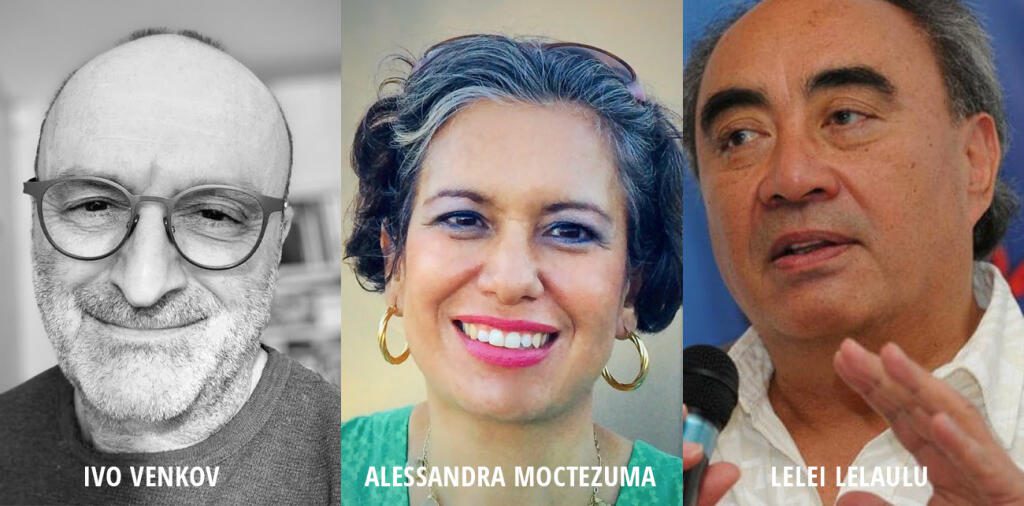
Ivo Venkov, Los Angeles based Bulgarian-American visual artist, architect, musician, and filmmaker. He founded PAA studio in 1992 as a multidisciplinary art collaborative
Alessandra Moctezuma, Artist, Curator, Professor of Fine Arts, Museum Studies, and Gallery Director at San Diego Mesa College
Lelei LeLaulu, development entrepreneur; the Mundo Maya Sustainable Tourism project he launched with National Geographic and US AID used archeology as a tool to give indigenous communities access to their architectural and cultural heritage, secured a fragile peace, trained female PhDs, and gave people sustainable livelihoods
 Vera Mijojlić, Moderator; founded the South East European Film Festival in Los Angeles (SEEfest). She began as a journalist and film critic in former Yugoslavia.
Vera Mijojlić, Moderator; founded the South East European Film Festival in Los Angeles (SEEfest). She began as a journalist and film critic in former Yugoslavia.
The Real Origin of Wine in South East Europe
Contrary to popular beliefs, wine did not originate in France.
Archaeologists found wine residue dating back to over 8,000 years ago in Georgia. It is said that the people of modern-day Georgia discovered that grape juice ferments to wine after it was buried underground during the winter months.
You may be familiar with the terms “old world” and “new world” when it comes to wine, referring to Europe and everywhere else, respectively. It’s a colonialist perspective, although sommeliers have adopted these terms when discussing winemaking regions and styles based on the origins of modern viticulture. However, Georgia and surrounding regions are actually “ancient world” wine producers, giving credit where it’s due to the true origins of winemaking.
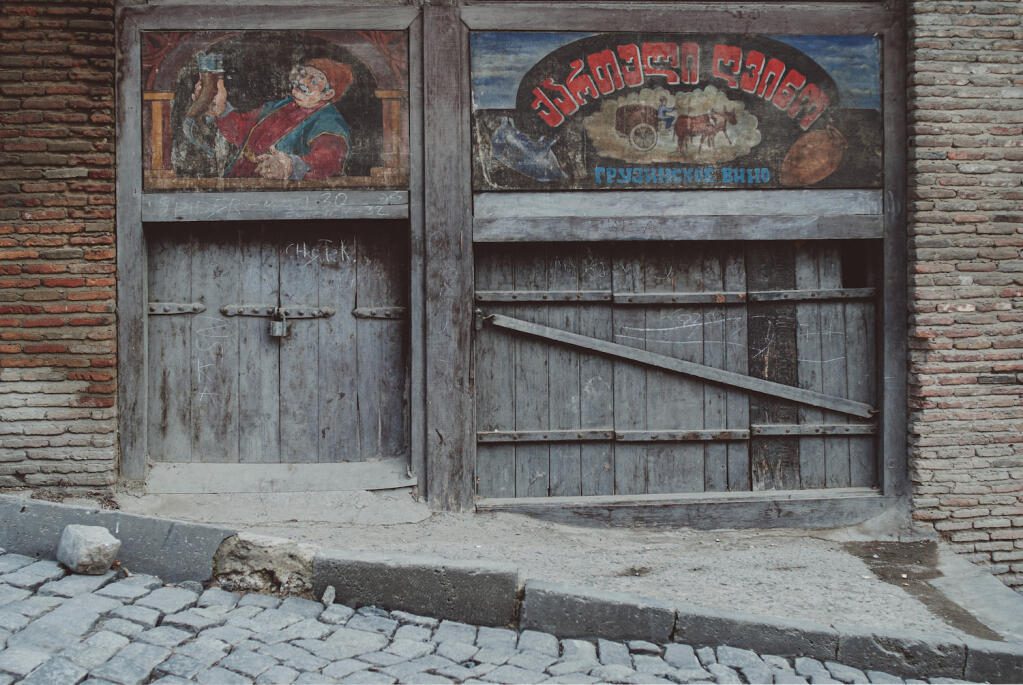
An old wine shop in Tbilisi. Photo by Egor Myznik.
Funny enough, some of the “hip” wines that are trending in the market today, like orange wine and ancestral sparkling wine are based on ancient winemaking techniques.
In the Ancient World, white wine grapes would be fermented with their skins on for more structure. Nowadays, it’s what we know as orange wine.
Ancestral method sparkling wine has its secondary fermentation in the bottle with live yeast cells that die and become lees. The secondary fermentation results in carbonation while the lees impart a toasty aroma, as is the case with all traditional method sparkling wines. However, in the modern traditional method, the lees are removed before the bottle is corked and sold to you. Meanwhile, ancestral method sparkling wine is sold to you unfiltered, just as it was enjoyed thousands of years ago.
Most of the wines that you’ll find from the ancient world are made using modern winemaking techniques. If you haven’t already tried them, browse the selection at your local wine shop! Cheers.
Read more about the archaeologists’ findings here.
SEEfest Alumna Gets Distribution for “HOMEMADE” Documentary Web Series
SEEfest Accelerator Alumna Ivana Strajin Joins Forces with Dunn Vision
Food is so personal. Growing up, some of my favorite childhood memories were those spent in the kitchen cooking with my dad and baking with my mom. As a kid, I didn’t realize that what we were preparing had any cultural significance. It was just food. I thought everyone in Toronto made sarma in the winter!
Now more than ever, I treasure these multi-generational family recipes as many members of the diaspora do. We preserve these recipes because they connect us, not only to our heritage but to loved ones, both alive and long lost.
HOMEMADE Celebrates Cultural Heritage Through Food
I knew that this personal connection to food was universal. I wondered what kinds of interesting stories we’d hear if we asked home cooks to tell us about their most treasured family recipes and the meaning behind them. Feeling inspired, I decided I wanted to create a web series that would shine a spotlight on home cooks. HOMEMADE was born.
Several Canadian home cooks agreed to share their stories. We went into their homes and kitchens. We filmed them as they prepared their favorite dish or meal. We interviewed them afterward. We asked them about the personal significance of the dish, and they shared more than just the mechanics of how to prepare the dish. They shared heartwarming stories and unique traditions associated with these deeply personal recipes.
HOMEMADE features recipes from all around the world, from South India to Haiti. However, there are seven episodes. Naturally, we could not get to every region! Perhaps it will be a possibility in the future.
Our very first episode features a home cook whose family heritage is from South East Europe! Yasemin Kamci shares her family’s Turkish-Cypriot dolma recipe.  For centuries, stuffed grape leaves have been a staple in the cuisines of countries across South Eastern Europe to Central Asia. Depending on where you enjoy these culinary delights, they may be referred to as dolma, dolmeh, sarmice… and more!
For centuries, stuffed grape leaves have been a staple in the cuisines of countries across South Eastern Europe to Central Asia. Depending on where you enjoy these culinary delights, they may be referred to as dolma, dolmeh, sarmice… and more!
Yasemin’s multi-generational recipe features grape leaves that are stuffed with rice, tomatoes, and herbs. It happens to be a completely vegan recipe. That said, it’s common to find variations on this recipe that include ground beef or lamb. Some include zucchini, peppers, and eggplants. Aside from regional nuances, every household has its own take on this classic dish.
In Yasemin’s family, dolma represented the start of summer in Ontario. Her parents grew grapevines in their backyard and would pick the leaves to make dolma. Everyone would save their appetite all day to leave room for their big dolma feast in the evening. While we couldn’t time travel to Yasemin’s childhood to film these family gatherings, Jane Guan, our animator, transports us there through her beautiful illustrations.
We featured Episode 1: Dolma by Yasemin Kamci in our short festival run. It was this very episode that caught the attention of the team at Dunn Vision. They saw the episode and reached out to me directly to include our series on their new streaming service. The episodes are now available for your viewing!
My hope for audience members is that you’ll resonate with the stories shared by our home cooks and continue to treasure your family recipes, traditions, and memories.
Watch all seven episodes here.
The Meaning of Mira Furlan
SEEfest had the honor of joining an international panel hosted by UCL, University College London, School of Slavonic and East European Studies on February 3rd, 2021 paying tribute to Mira Furlan. You can watch the conversation below.
The recently departed Mira Furlan (1955-2021) was a legend of Yugoslavian theatre and cinema, representing the hopes and visions of a generation both through her artistic work and her political and social engagement. 
Ousted from her job at the Croatian National theatre and driven from her home by a vicious campaign of threats and media defamation, she remade her career in the United States, where she achieved success in popular television series including Lost and Babylon 5.
For many people in the region, she remains an icon of artistic quality, integrity, and courage in the face of adversity.
Her passing is a moment to consider not only this extraordinary artist but the issues that she confronted and partly conquered: the role of the artist in a conflicted society, the complex interaction involving socialism, nationalism, and culture, the constrained representation of women, and gendered relationships, and the parts of the society that have survived the transformation of cultures into mutually hostile camps.
Our panel of cultural scholars and creators/critics of culture will consider Mira Furlan’s contribution and the current condition of cultural life in the region.
The panel includes Sanjin Pejković, associate professor of film studies at Dalarna University, singer and songwriter, Sara Renar, and SEEfest’s very own festival director, Vera Mijojlić. The panel was moderated by Eric Gordy, Professor of Political and Cultural Sociology.
Exploring The Adriatic Coast of South East Europe
Often considered among the most beautiful waters to see and swim in, the Adriatic Sea is an integral part of life in South East Europe, specifically in Croatia, Slovenia, Montenegro, Albania, and Italy, whose borders run along the Adriatic coast.
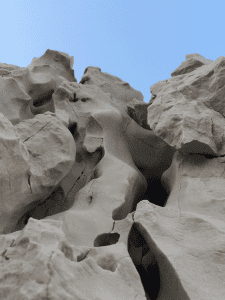 One of the Adriatic coast’s striking features is the white stone which marks the ever-shifting boundary between land and sea. Near the water, the stone is encrusted with shells and barnacles, colored brown with seaweed and centuries of erosion. Farther from the shore the stone is pale, textured with indentations, and laced with cracks and schisms. Rosemary bushes and pine trees are found close enough to the shore that their branches hang over the water, creating shadowed nooks and clusters of pine needles among the rocks.
One of the Adriatic coast’s striking features is the white stone which marks the ever-shifting boundary between land and sea. Near the water, the stone is encrusted with shells and barnacles, colored brown with seaweed and centuries of erosion. Farther from the shore the stone is pale, textured with indentations, and laced with cracks and schisms. Rosemary bushes and pine trees are found close enough to the shore that their branches hang over the water, creating shadowed nooks and clusters of pine needles among the rocks.
On sunny days, sailboats and ferries dot the horizon, along with smaller fishing boats, especially near villages. Ferries carry the local inhabitants of the islands to and from cities, and during the summer they run every few hours. The sea is also home to over 7000 plant and animal species and is so clear that while swimming one can see the fish, either lurking near the seafloor or else darting synchronously through the waves in schools.
Some jump above the surface, a quick gleam of silver in the sunlight before disappearing underwater again. Squids, crabs, dolphins, and other common marine wildlife are also found in these waters, and there are rarely any large or dangerous creatures, though the occasional lost fin whale or young shark appears while searching for a way back to the Mediterranean.
In recent years, concerns about threats to marine ecosystems in the Adriatic have grown, including worries about overfishing and pollution; these are the same problems plaguing coastal environments all over the world right now. Poor waste management and carelessness from tourists has led to trash floating in the sea and washing up on shores, which in turn affects the wildlife.
Although it is still safe to eat fish from the Adriatic, pollution may change that in the future. Moreover, of the over 450 fish species identified in the Adriatic, about 60 are considered endangered or nearly endangered, according to various red lists on endangered species in the Mediterranean and Adriatic.
Pollution concerns are exacerbated by commercial endeavors, especially cruise ships, which have become a frequent sight in ports. Although they bring tourists and therefore business, the environmental damage to the coast has caused many to question them and look for alternatives, such as more 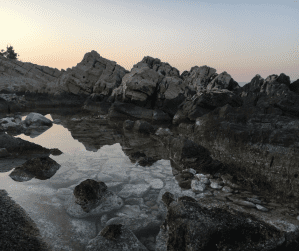 traditional-style ships which can also carry tourists between Adriatic islands and cities. Split and other large coastal cities have a rich history of flourishing shipyards and capable sailors, and have produced all kinds of vessels. Their older ships have a long history, such as the Polaris, which travels between Split and several nearby islands. Polaris has been run by the same local family for decades and its existence stretches back to World War II. Although its exterior has been restored and rebuilt over the decades, it nevertheless carries history in its foundations as it continues to sail through the Adriatic.
traditional-style ships which can also carry tourists between Adriatic islands and cities. Split and other large coastal cities have a rich history of flourishing shipyards and capable sailors, and have produced all kinds of vessels. Their older ships have a long history, such as the Polaris, which travels between Split and several nearby islands. Polaris has been run by the same local family for decades and its existence stretches back to World War II. Although its exterior has been restored and rebuilt over the decades, it nevertheless carries history in its foundations as it continues to sail through the Adriatic.
As with every coastal region, the priority is to preserve and find a coexistence between the natural environment and our own interaction with it. From its storms carrying heavy winds and salt, to its days of pristine tranquility under the sun, the Adriatic is a force of its own, always shaping the landscape and the homes we have built beside it.
South East European Artists Make History in Hollywood
We salute artists from Southeast Europe whose accomplishments this year are for the history books.

Maria Bakalova makes history as the first-ever Bulgarian actress to be nominated for the Golden Globe award.
Maria Bakalova – She has just made history this Wednesday as the first-ever Bulgarian actress to be nominated for the Golden Globe award, for her breakout role in “Borat Subsequent Moviefilm.” Eastern European actors have rarely if ever received recognition from U.S. entertainment industry power brokers and Bakalova’s nomination has now shattered that proverbial glass ceiling. This was followed by Screen Actors Guild nomination, making it highly likely that Bakalova might also get the nod from Oscar voters.
Blerta Basholli, director of “Hive” from Kosovo – hers is the first film in Sundance history to win all three main awards, the Grand Jury Prize, the Audience Award and the Directing Award in the World Cinema Dramatic Competition, for the powerful women-centric film that resonates with women everywhere.
Alexander Nanau, Romania – His documentary powerhouse “Collective” received multiple awards and nominations, including nominations for Film Independent Spirit award and International Documentary Association’s (IDA) Best Feature Documentary award, while garnering over 60 other awards and noms worldwide. (Watch SEEfest conversation about Collective.)
Radu Ciorniciuc and Mircea Topoleanu, Romania – Their film, “Acasă, My Home“ has been nominated for the Cinema Eye Honors and IDA’s award for Best Cinematography, in addition to more than 30 other noms and awards worldwide.
Maja Novaković, Serbia – Her debut short doc “Then Comes the Evening” amassed more than 80 awards around the world, including a nomination for the Cinema Eye Honors award, to be held in March. (Watch SEEfest Conversation about the documentary.)
Dalibor Barić, Croatia – his avant-garde animated feature “Accidental Luxuriance of the Translucent Watery Rebus” has just qualified for consideration in the Academy’s animated feature film category, alongside the top industry heavyweights.
These are just a few most recent and most prominent examples of the creative potential of Southeast Europe.
Join the international community of artists and arts patrons who have made SEEfest their outpost and champion in Hollywood.

Get involved, be an advocate, share your story about Southeast Europe.
Make your voice heard and celebrate the quality and artistry of the new generation of filmmakers, writers, composers, illustrators, cinematographers – while honoring those who came before and paved the way for today’s breakout artists.
We invite you to join us today as a Cine-Fan and become part of the story, lending a hand in shaping the future and traveling with movies to the roads less traveled and leading to exciting new discoveries and new friendships.
Cornmeal—Originated in the Americas, A Staple Ingredient Binds Many Cultures Together
Corn, or maize—its indigenous name, was first domesticated in the Americas around 10,000 years ago by indigenous people. Today, it is one of the topmost distributed food crops around the world—even more than that of wheat or rice—and has various purposes such as biofuel, animal feed, cornstarch, corn syrup, and raw-eco material.
Now that we’ve got that covered, let’s head into the yummy part of this topic—the varying—but all so delicious—takes on the use of cornmeal (maize that is dried and ground) which first began in the Americas!
From Mexico to Bosnia
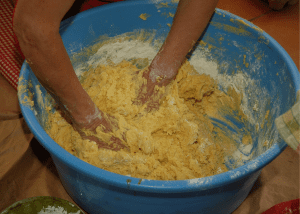 In numerous North, Central, and South American countries, cornmeal is used to make masa (corn flour typically mixed with either lime water or lard), a staple ingredient used for various flavorful dishes throughout the region.
In numerous North, Central, and South American countries, cornmeal is used to make masa (corn flour typically mixed with either lime water or lard), a staple ingredient used for various flavorful dishes throughout the region.
For instance, in Mexico, cornmeal is the main component in many meals. Masa is used for things like tortillas (which is a key food), atole (a masa-based hot drink), and tamales—which is masa stuffed with various fillings and encased in corn husks!
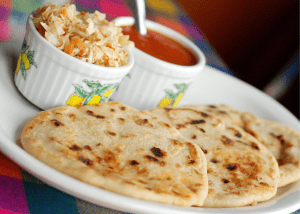
In Colombia and Venezuela cornmeal is used to make the maize-dough for arepas, which, similarly to tamales, are filled with varied stuffings. However, they bear more of a resemblance to pupusas from El Salvador (which also contain different fillings) as they are similar in design and are both typically fried.
Then in places like the United States of America, Italy, and Romania, cornmeal is used to make their own delectable creations—which are all varying versions of a sort of cornmeal porridge.

The Southern United States is known for grits, but this meal actually originated from the Muscogee (Creek) Natives who first created this style of dish. Grits are boiled cornmeal, which turn into a porridge, and is now typically served for breakfast, but can also be a dinner entree as a sort of side that would normally be rice or mashed potatoes.
Italy and Romania’s use of cornmeal is more similar to each other than with the Southern United States because they were both introduced to corn in the 16th century by the Turks. They then planted the corn, which resulted in them making a mush with their reapings.
In Italy, they named it polenta, and the Romanians named it mamaliga, but they are similarly made. For both recipes, the cornmeal is boiled in either water, stock, or milk, with some sort of cheese, herbs, and butter.
Another tasty dish is pura, which comes from Bosnia and Herzegovina. It is polenta that’s been boiled in water and oil and is finished once the liquids vaporize. The pura is then topped with a mixture of cottage cheese and yogurt, finishing it off with garlic and a bit of butter.
All of these regions mentioned, though vastly different, share a common appreciation for the corn first introduced by the Indigenous of the Americas, and all have a delicious dish centered around the use of cornmeal.
What’s your favorite dish made with cornmeal?
Scroll down to share with us in the comments!


